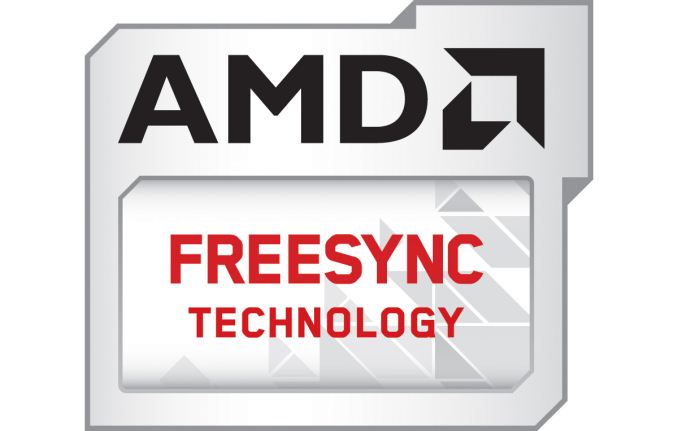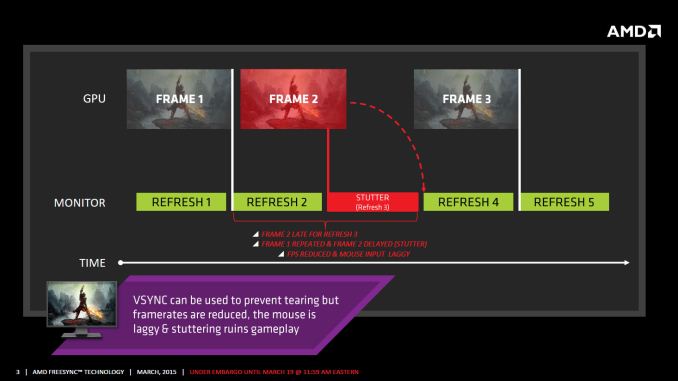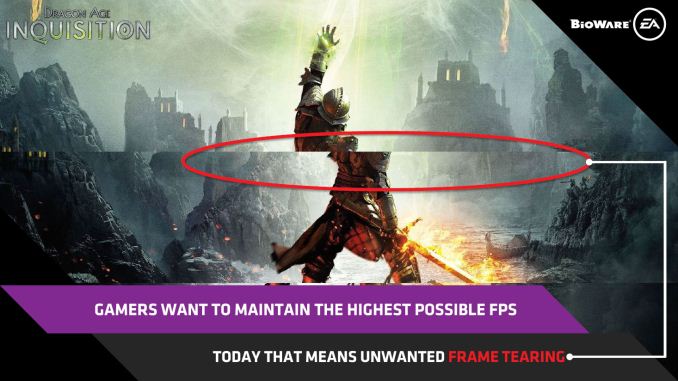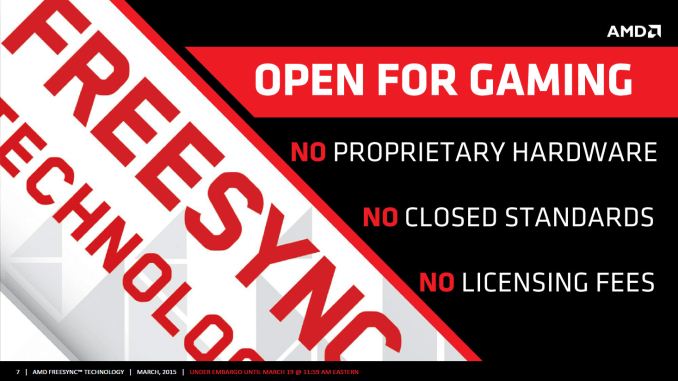The AMD FreeSync Review
by Jarred Walton on March 19, 2015 12:00 PM EST
Introduction to FreeSync and Adaptive Sync
The first time anyone talked about adaptive refresh rates for monitors – specifically applying the technique to gaming – was when NVIDIA demoed G-SYNC back in October 2013. The idea seemed so logical that I had to wonder why no one had tried to do it before. Certainly there are hurdles to overcome, e.g. what to do when the frame rate is too low, or too high; getting a panel that can handle adaptive refresh rates; supporting the feature in the graphics drivers. Still, it was an idea that made a lot of sense.
The impetus behind adaptive refresh is to overcome visual artifacts and stutter cause by the normal way of updating the screen. Briefly, the display is updated with new content from the graphics card at set intervals, typically 60 times per second. While that’s fine for normal applications, when it comes to games there are often cases where a new frame isn’t ready in time, causing a stall or stutter in rendering. Alternatively, the screen can be updated as soon as a new frame is ready, but that often results in tearing – where one part of the screen has the previous frame on top and the bottom part has the next frame (or frames in some cases).
Neither input lag/stutter nor image tearing are desirable, so NVIDIA set about creating a solution: G-SYNC. Perhaps the most difficult aspect for NVIDIA wasn’t creating the core technology but rather getting display partners to create and sell what would ultimately be a niche product – G-SYNC requires an NVIDIA GPU, so that rules out a large chunk of the market. Not surprisingly, the result was that G-SYNC took a bit of time to reach the market as a mature solution, with the first displays that supported the feature requiring modification by the end user.
Over the past year we’ve seen more G-SYNC displays ship that no longer require user modification, which is great, but pricing of the displays so far has been quite high. At present the least expensive G-SYNC displays are 1080p144 models that start at $450; similar displays without G-SYNC cost about $200 less. Higher spec displays like the 1440p144 ASUS ROG Swift cost $759 compared to other WQHD displays (albeit not 120/144Hz capable) that start at less than $400. And finally, 4Kp60 displays without G-SYNC cost $400-$500 whereas the 4Kp60 Acer XB280HK will set you back $750.
When AMD demonstrated their alternative adaptive refresh rate technology and cleverly called it FreeSync, it was a clear jab at the added cost of G-SYNC displays. As with G-SYNC, it has taken some time from the initial announcement to actual shipping hardware, but AMD has worked with the VESA group to implement FreeSync as an open standard that’s now part of DisplayPort 1.2a, and they aren’t getting any royalties from the technology. That’s the “Free” part of FreeSync, and while it doesn’t necessarily guarantee that FreeSync enabled displays will cost the same as non-FreeSync displays, the initial pricing looks quite promising.
There may be some additional costs associated with making a FreeSync display, though mostly these costs come in the way of using higher quality components. The major scaler companies – Realtek, Novatek, and MStar – have all built FreeSync (DisplayPort Adaptive Sync) into their latest products, and since most displays require a scaler anyway there’s no significant price increase. But if you compare a FreeSync 1440p144 display to a “normal” 1440p60 display of similar quality, the support for higher refresh rates inherently increases the price. So let’s look at what’s officially announced right now before we continue.













350 Comments
View All Comments
imaheadcase - Thursday, March 19, 2015 - link
The cost means nothing, keep in mind the people buying this stuff pay out the nose already for hardware. Given that most people who by nvidia cards are going to get a Gsync, cost has no meaning.This is a double bad thing for AMD..first its still tied to IT'S graphics card (NV already so no to support), and 2nd the monitors announced already are already below the specs Freesync is suppose to do, and worse than next gen Gsync monitors.
I mean i love competition like the next person, but this is just PR making it seem like its a good thing when its not.
SleepyFE - Thursday, March 19, 2015 - link
Your name says it all. Do you really think manufacturers will beg NVidia to come and mess with their manufacturing process just to include something that only they support? Time will come when phone makers will join and they mostly don't use NVidia GPU's. So now you have NVidia vs AMD and Intel (for ultrabooks) and ARM (Mali) and PowerVR. You think NVidia can hold them off with overpricing and PR?Murloc - Thursday, March 19, 2015 - link
uhm no?I'd want my next monitor to be GPU agnostic ideally.
And I'd want to use an nvidia card with it because right now AMD cards are still ovens compared to nvidia.
Not because I like paying through the nose, a 750 Ti doesn't cost much at all.
I'll hold out since I'm trusting that this thing will solve itself (in favour of the industry standard, adaptive sync) sooner or later.
Ranger101 - Friday, March 20, 2015 - link
So a difference of 10 degrees celsius under load makes an AMD gpu an OVEN and an Nvidia gpu presumably a Fridge by comparison....LOL.Lakku - Wednesday, May 6, 2015 - link
The reported GPU temp means nothing. That is just an indication of the heatsink/fans ability to remove heat from the GPU. You need to look at power draw. The AMD GPUs draw significantly more power than current nVidia cards for less performance. That power generates heat, heat that needs to go somewhere. So while the AMD cards may be 10 degrees Celsius more, which isn't minimal in and of itself, it is having to dissipate quite a bit more generated heat. The end result is AMD GPUs are putting out quite a bit more heat than nVidia GPUs.althaz - Thursday, March 19, 2015 - link
There are a bunch of 4k monitors announced. Yet there are no 4k G-Sync monitors available - how is that worse specs?I'd buy a 4k 27" G-Sync display at a reasonable price in a heartbeat. In fact I'd buy two.
thejshep - Thursday, March 19, 2015 - link
Acer XB280HK http://www.newegg.com/Product/Product.aspx?Item=N8...arneberg - Thursday, March 19, 2015 - link
Freesync today are only open to people with radeon cards. AMD made the better deal they let the monitor builders take the cost for freesync. Nvidia made the hardware themselfchizow - Thursday, March 19, 2015 - link
Huh? Who cares if its open/closed/upside down/inside out? G-Sync is better because it is BETTER at what it set out to do. If it is the better overall solution, as we have seen today it is, then it can and should command a premium. This will just be another bulletpoint pro/con for Nvidia vs. AMD. You want better, you have to pay for it, simple as that.lordken - Thursday, March 19, 2015 - link
better? did we read same article? I cant find where it says that gsync is better than freesync. In what aspect it is better?And answer for your 1st question is, anyone with the brain. Thing is that nvidia could enable support for freesync if it wouldnt hurt their pride, which would be big benefit for their customers (you wouldnt be restricted on monitor selection) but they chose what is better for them, pushing gsync & milking more money from you.
This is pretty stupid, while you may be some average gamer that thinks it is fine to have your monitor selection restricted to 2% normal people probably wouldnt be that happy. The way it should be is that every monitor should support freesync (or whatever you call it) as this is display feature and should have been in 1st place developed by LCD makers but they dont give a shit to provide excellent displays as far as they can sell shit that people are buying like crazy (not refering to gsync monitors now).
Vendor lockin is always a bad thing.
Oh and article says that gsync monitor doesnt provide advanced OSD as comon panels today...so yeah gsync is clearly better